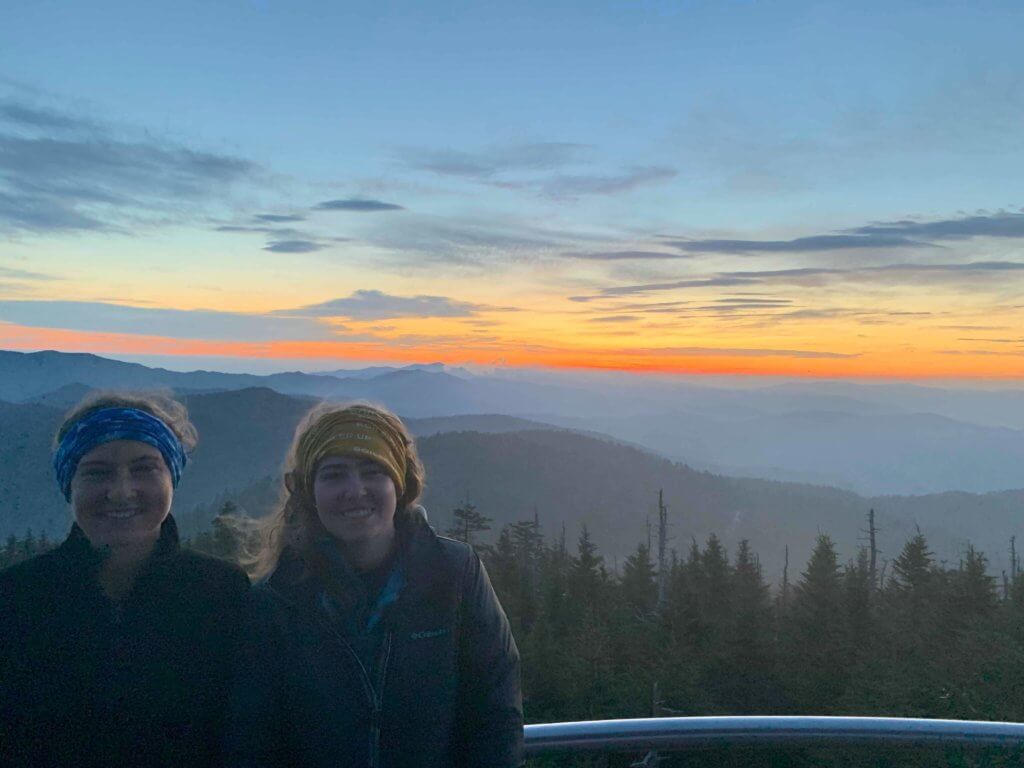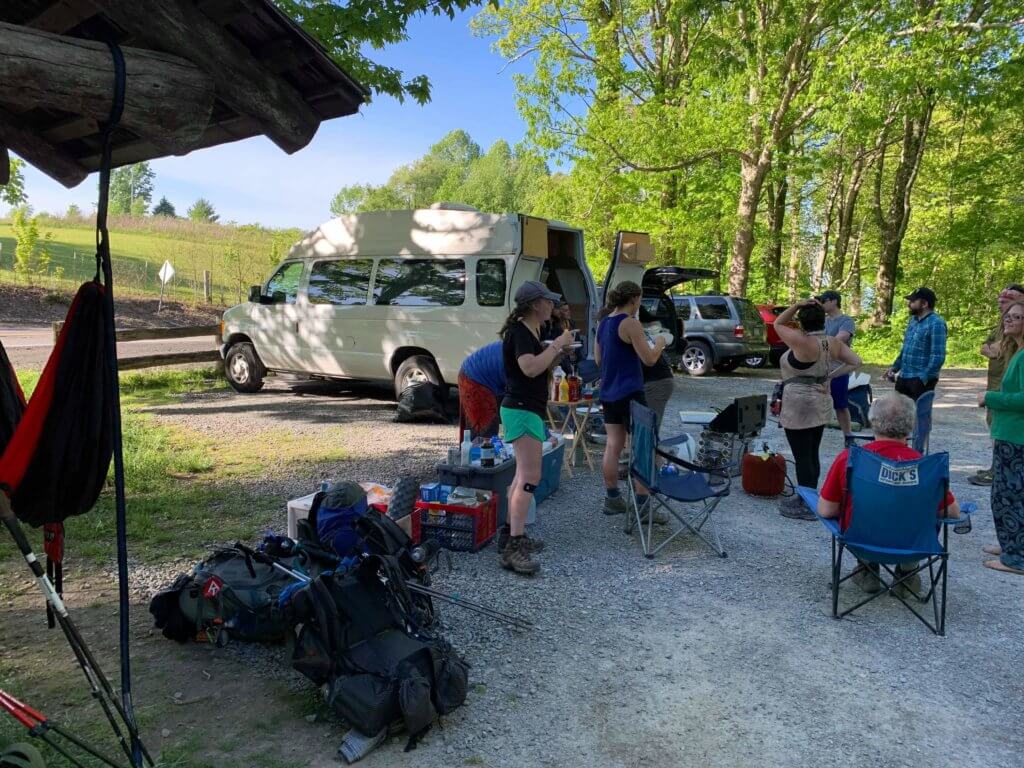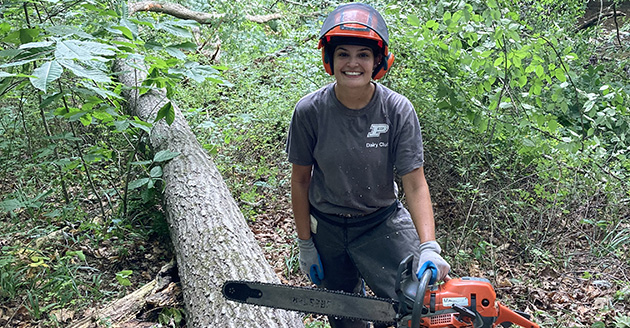Purdue Forestry and Natural Resources (FNR) alumnae Rebekah Lumkes and Baleigh Haynes joined an elite group of individuals, completing a 2,192 mile thru-hike of the Appalachian Trail. For one, it was the culmination of a college pipedream. For the other, it offered a much-needed life reset. Here is their story.
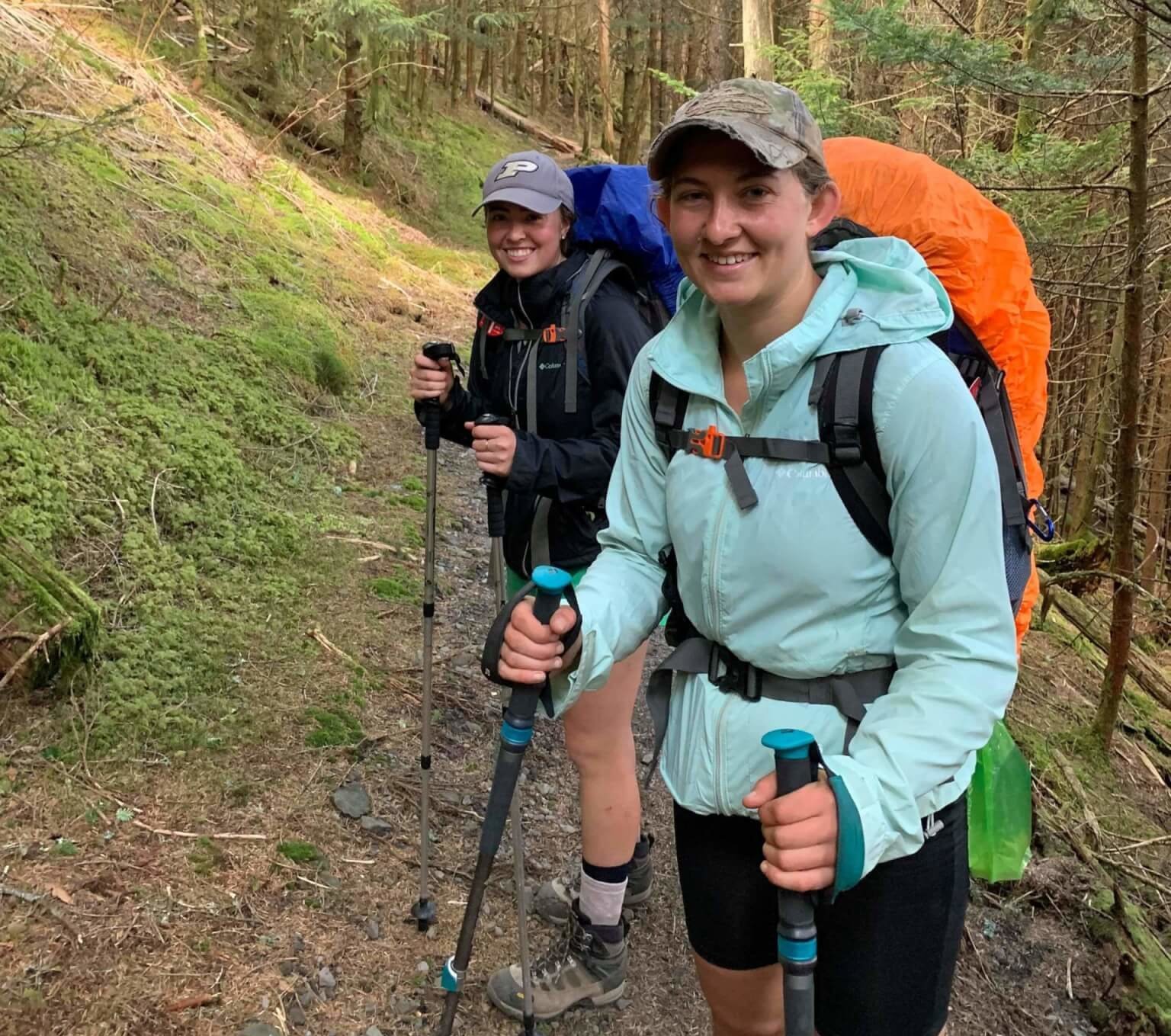 It had all of the makings of a Hollywood movie. Two best friends setting out on an epic journey covering nearly 2200 miles, coupled with sweeping mountain views, various national geographic quality landscapes, encounters with wildlife and finding a common bond with a community of fellow wayfarers.
It had all of the makings of a Hollywood movie. Two best friends setting out on an epic journey covering nearly 2200 miles, coupled with sweeping mountain views, various national geographic quality landscapes, encounters with wildlife and finding a common bond with a community of fellow wayfarers.
Add in torrential downpour and hail soon after the first steps, bouts with sickness, an onslaught of bug bites and the periodic/overwhelming internal struggle to persevere.
But this was no Hollywood movie. For 2017 Purdue Forestry and Natural Resources alumnae Rebekah Lumkes and Baleigh Haynes this was simply the spring and summer of 2019 on the Appalachian Trail as the pair became part of an elite group of just 25 percent of individuals who complete the 2,192 mile thru-hike.
For one, it was the culmination of a college pipedream. For the other, it offered a much-needed challenge and life reset. Here is their story.
Setting the Stage: the Journey to 5 Million Steps
“I don’t remember when I first heard about the trail, but I know my sophomore year of college I went hiking and I was like, ‘I really want to thru-hike sometime, maybe I’ll do it after I graduate,’” Lumkes recalls. “And then graduation came and I was not prepared and I didn’t have time. I still wanted to do it, I just didn’t know when.”
When Rebekah shared her dream with her best friend, Baleigh was supportive, but never thought she would be a part of such a quest.
“When we were in college, Rebekah always said something about “oh, it would be so cool to hike the Appalachian Trail,” Haynes said. “I would be like ‘yeah, that would be totally cool,’ knowing very well that I would never do it because it was outside of my comfort zone.
“Then in the summer of 2018, I went through some life changes and I was like, you know what I really need is just to do something outside of my comfort zone, something that I would normally be too afraid to do, so I just called Rebekah up and said ‘what are you doing next summer? Do you want to hike the Appalachian Trail with me?’ That’s how it all got started. I just called her up one day and said, ‘Let’s go do this.’”
Fortunately for both women, the seasonal or short-term nature of their jobs allowed for them to take four and a half months off for the trip by simply not renewing contracts.
Lumkes had been working in technician jobs that were three to six months in duration. Her last one ended in April and she left straight from there to head to the trail.
Haynes was working as a naturalist at the nonprofit Dunes Learning Center, a job that she ‘absolutely loved and was sad to leave.’ She left a month and a half early from her one-year contract to start the trail.
Studying the Script: Getting Ready
After Haynes’ phone call, the pair began doing a lot of research, reading different blogs and accounts from people who had completed the hike. They put together a gear list and began to determine how long the trek would take and how much money would be required to complete it.
“We did a lot of planning, but we definitely could have done more,” Lumkes admits. “The biggest thing that we had to look into was gear. Baleigh had never backpacked before, so she definitely needed gear, and I had only done a little bit, like short trips, so there was a lot of stuff that we needed to buy. Then there are some things that we learned you just really can’t prepare for. There was a lot of talk about things like what do we think we are going to want to eat and how often do we want to stop in town. Little stuff like that definitely changed on the trail, but we definitely tried to plan it out ahead of time."
“And both of us were trying to get into hiking shape, which didn’t really work. We’ve done the trail and we were NOT in hiking shape.”
Haynes recalls her attempts at preparation often came up short.
“I did kind of bare minimum preparation compared to a lot of the hikers that we met on trail,” Haynes shared. “I had only been camping maybe twice in my life and my first experience ever backpacking was hiking the trail. I had three different books on people’s experiences and how to prepare and I honestly didn’t finish any of them. I looked up online suggestions of what to pack and to answer other questions like how do I go the bathroom as a woman and other things like that. I was just given a backpack and a sleeping bag and thought how hard can it really be…"
“You don’t truly understand what you do need and don’t need until you are there. When we started, we thought we had the bare minimum things, but it is amazing the different things we cut out as we were hiking. There was a gentleman that helped us at the very first town stop three days in who taught me how to pack my pack and he did a pack shakedown for us and we ended up mailing a bunch of things home.”
By the end of the trip for instance, Lumkes had cut her clothing supply down to two shirts and two pairs of shorts in order to carry as little weight as possible.
A Journey Starts with a Single Step, in the Rain . . .
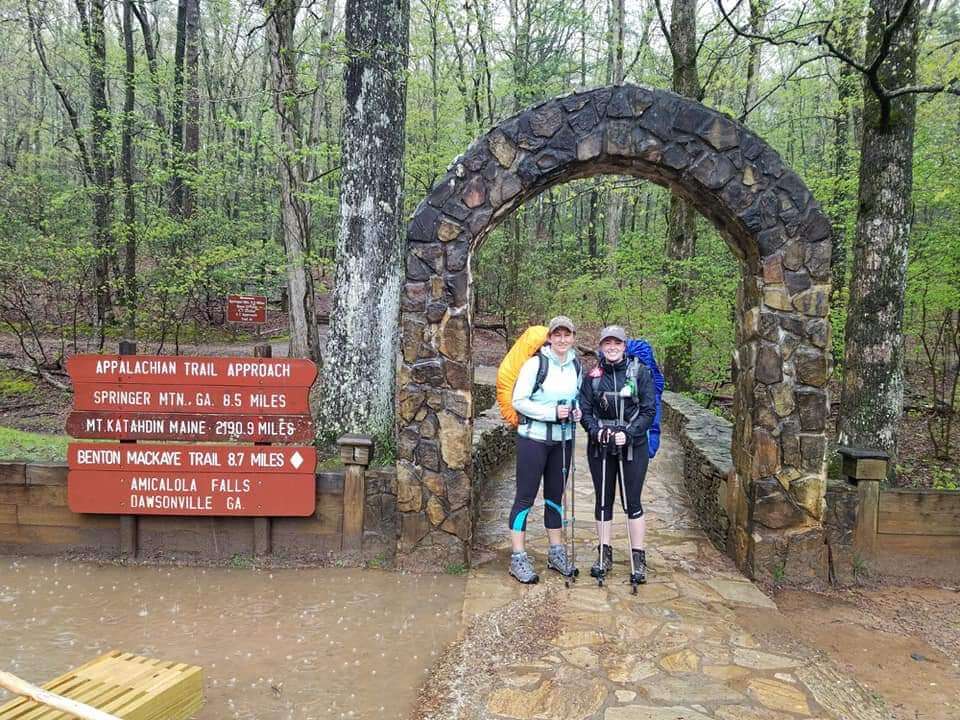 When Haynes’ mother dropped the pair off in Springer Mountain, Georgia, they signed up and got their start number and all quickly became real.
When Haynes’ mother dropped the pair off in Springer Mountain, Georgia, they signed up and got their start number and all quickly became real.
“We started in severe weather – it was like thunderstorms and there were tornado warnings,” Haynes recalls. “We were like well, I guess we might as well get used to the rain now on Day 1. Everything was soaked on our first day. It was an experience. Day 2 we were just like let’s get to camp and dry out our stuff.”
But the early testing showed the pair that they had the perseverance to carry on, something they took with them the rest of the journey.
“We got hail our first week in and then a lot of rain and some snow,” Lumkes said. “One morning, I don’t know how many miles we were originally going to hike, but we ended up doing seven to a shelter. It had been raining all morning, so we got there soaking wet, stripped down, put dry clothes on and I got in my sleeping bag and was making hot oatmeal to warm up. Then our friend got there and was like, ‘guys we should go another seven miles.’ We were all settled in for the day, but we said ok and we had to put our wet clothes back on and head back out in the rain. I think that was a defining moment in our trip, where we were like well, if we just did 14 miles in the rain, had to stop halfway through and then push through again, we can probably do anything.”
For Rebekah, relief came in the form of music and podcasts. “I figured that if I spent all morning hiking and enjoying nature and being unplugged, I might want something to do later on in the day or vice versa. For the first three weeks, I don’t think I listened to anything. I was just hiking every day, enjoying the views and talking to other hikers and that was really refreshing. Even after that, I might put music on once a week, but near the end I listened to more podcasts when I was sick and needed a little something extra to focus on besides just walking.”
Baleigh shared how she used pep talks from home to push through the doubt and urge to give up.
“I was sick through Massachusetts, Vermont and New Hampshire and got better when we were starting Maine,” Baleigh said. “Every day when I was sick I was calling my fiancé and saying ‘I don’t know why I’m out here, I just want to quit’. That’s why I needed pep talks. He would say ‘You don’t actually mean that, you are just saying that because you are sick and it is hard to breathe.’ For that month, it was absolutely miserable. I wanted to quit every single day, but I was like ‘I can’t even quit because I don’t have a way home from where I am at, the only way I can get home is if I keep walking.’”
Rebekah shared the importance of perseverance. “You have to stay very mentally focused. I really enjoyed almost every day, so that wasn’t a huge problem, but at the end I got really sick and then it was a problem. With about two weeks left, I came down with what I think was bronchitis. I had a really bad cough, I had a fever and I couldn’t eat anything, which is a problem when you’re burning 6,000 calories a day hiking. I felt awful and it was pretty challenging to tell myself, ‘I’ve got to keep moving.’ I wanted to be enjoying it and I wasn’t, so it was hard trying to get in that mindset.”
Behind the Scenes: The Logistics, Cast and Crew
 Baleigh and Rebekah ended up hiking around 22 miles a day, although they had some zero days as well, meaning they were on the trail, but didn’t hike that day. They also took 10 days off in July, leaving the trail to come home for the weddings of Rebekah’s sister and also another friend.
Baleigh and Rebekah ended up hiking around 22 miles a day, although they had some zero days as well, meaning they were on the trail, but didn’t hike that day. They also took 10 days off in July, leaving the trail to come home for the weddings of Rebekah’s sister and also another friend.
Their total time on trail was four and a half months, not including those 10 days away. The pair began the hike April 15 in Springer Mountain, Georgia, and ended Sept. 5 by summiting Mount Katahdin at Baxter State Park in Maine.
The majority of their nights were spent camping in a tent. Once every week or every week and a half, the pair would stay in either a hotel or a hostel or someone’s house.
They would periodically visit the towns, located every three to four days along the way, to buy supplies and food, to shower and just recharge, both physically and as well as their cell phones, many times courtesy of Trail Angels, the people who help make the journey possible.
Trail angels and trail magic, terms mentioned often in conjunction with hiking the Appalachian Trail, can offset some costs, but the impact of these important people and acts cannot be overstated nor can the comradery of the hiking community.
“Trail magic is anything that anyone does for a hiker,” Rebekah shared. “Sometimes it is just leaving water out for hikers when there are sections for a long period without any creeks or other water source. Sometimes it would be something simple, like I passed a day hiker on the trail one day and he was like, ‘oh, you’re a thru-hiker, here, have a Snickers bar.' Then sometimes it would be people who would come out to the back roads with their truck and a portable grill and make hamburgers and have a whole feast laid out for us or places to charge our phones. Then, there were trail angels who gave us rides into town or let us stay at their house.
“It’s really incredible how the community around the trail takes care of the hikers. Everyone is willing to help each other and that definitely impacted me. We were talking about trail magic at dinner one night with some trail angels who let us stay at their house and they were like ‘you know you can do trail magic any day of your life, you just have to help people.’ I’ve always wanted to do that, but now it is much more of conscious thought. I want to make sure that I’m providing trail magic in different forms every day.”
Baleigh also recalls the blessings and friendships made along the way.
“I’d say the best part of the trail is the people,” Haynes said. “We were truly blessed with the people that we met, both the hikers on the trail and the hiking community around the trail. The community’s help really makes hiking the trail possible. There were countless times when random strangers just pull up to the side of the road and ask if you want a ride into town or food or water or medicine or supplies. They are just these incredible people sacrificing their time and resources to help strangers.
“We also created trail families from the people that we were hiking around every single day. It’s just amazing how instantly you become best friends with someone. There’s nothing quite like hiking for months at a time and they are going through the exact same thing. Some of our really good friends – we are still good friends with them – we met and hiked large sections of the trail with. One guy that we met on our very first night, we walked over 700 miles with. Then, we met another girl in Virginia who was 24 and from Indiana and we hiked probably around half the trail in chunks with her. We ended up summiting together in Maine.”
Training Pays Off: Utilizing Their FNR Skillset
As Purdue wildlife alumnae, Rebekah and Baleigh were able to utilize their backgrounds to enhance the hiking experience, spotting various animals, foraging and seeing the landscape as more than just something pretty to look at.
Preparation from plant and wildlife identification classes allowed the pair to spot birds, find alternate sources of food and protect fellow travelers from dangerous plants, such as poison ivy.
“We kept a bird list the entire time because I’m really big into birding, which was definitely from classes,” Rebekah said. “We were probably some of the few hikers who knew all of the different plants out there. By no means did we survive on wild food, but we would forage pretty frequently. I ate violets throughout the hike and we found some edible greens one night and put them into our ramen. Knowing the plants was really helpful and really fun. You can also see the changing habitats as you move north. A lot of the stuff that you learn in class about high up on mountains vs. lower elevations, we got to see that firsthand. The classwork and everything we learned definitely came in handy and we put it to use every single day.”
The classwork and everything we learned (in FNR) definitely came in handy and we put it to use every single day.
- Rebekah
Baleigh noted the ID classes made the journey more enjoyable.
“Rebekah is fantastic at dendrology so she would quiz me on things,” Baleigh said. “We are both into birding, so that was fun. Knowing what poison ivy looked like was really helpful for everyone we hiked with. One person we were hiking with had no idea what it looked like, but he was really allergic to it, so we would tell him this is what it looks like so be careful. There is a little trick I use when I teach kids about poison ivy and what it looks like, so I taught that to the other hikers.
“It was also great that we knew what wild edibles were out there in what seasons. We were walking up the coast as berry season was coming along, so we were able to tell people to try different things and also pick different things to add to our meals. Our background gave us further knowledge and an overall appreciation of where we were and what we were hiking through. It was incredible seeing that this isn’t just a tree or a rock, this is an incredible habitat that so many animals and plants need and use and we got to be a part of it.”
Speaking of animals, the birds were not the only wildlife the hikers saw along the way.
“I think I got up to 13 bears by the end of the trip,” Rebekah recalled. “Most of them would just run away as soon as they saw hikers. But, there was one morning that I left really early before everyone else and it was still kind of dark outside. I was hiking by myself and I looked over and saw a mom – a sow – bear with a cub and they were just browsing some food over there and grazing and didn’t see me at all. That’s always one of my favorite encounters – when I can watch wildlife just acting naturally without me disturbing them. I watched them for a few seconds and then continued hiking and they continued eating. It was a really cool encounter.”
It was an encounter with a flying squirrel as well as some deer and bears that stuck out to Baleigh.
“We mostly saw bear butts; they pretty much ran away as soon as they saw or heard us,” she said. “The deer were pretty friendly along the trail. They wouldn’t run away right away. It is always cool to see wildlife up close. I personally ran into an unfortunate situation with a flying squirrel. It ate through my food bag and ate my trail mix. I was very sad about that. For the most part, animals are aware that we are people and are kind of scary so they stay away for the most part. I was a little bummed I didn’t get to see a moose, but maybe it’s a good thing I didn’t run into one.”
Reaching the Climax: Summiting Katahdin - A Tale of Two Climbs
As the final day of their hike approached, emotions ran high, not only because the journey was coming to an end, with just five miles remaining, but because challenges lie ahead.
Baxter Peak at Katahdin is 5,267 feet in elevation.
Baleigh was the first to reach the summit.
“It was a roller coaster of emotions from being really excited and then absolutely terrified and then excited again and stunned that I was done,” she shared. “By the end of the trail I was personally ready to be done. I was tired and ready to go home, but then starting the last day, I was full of energy and excited. We had just five miles to get to the summit, then we got to some bouldering parts, which were actually pretty fun. But once we got above tree line, I would say my attitude changed. When we were above tree line and bouldering, there were over 30 mile per hour winds and it was probably the most scared I had felt on the trail. I felt like I was going to be blown off the mountain. There were giant drop offs on both sides of us and you have to have three points of contact at all times.
“By the time I got almost to the top, I was absolutely ready to be done. I was so thankful I was almost there, I was not enjoying it, but once we got past the part where it was really windy, we had a half mile left and you could see the summit. Then I was just absolutely full of happiness and like, ‘oh my goodness, I can’t believe it’s done’. It was kind of weird thinking about the fact that tomorrow I was going to wake up and not just hike.”
Baleigh was at the top waiting for Rebekah to make her way to the coveted Katahdin sign.
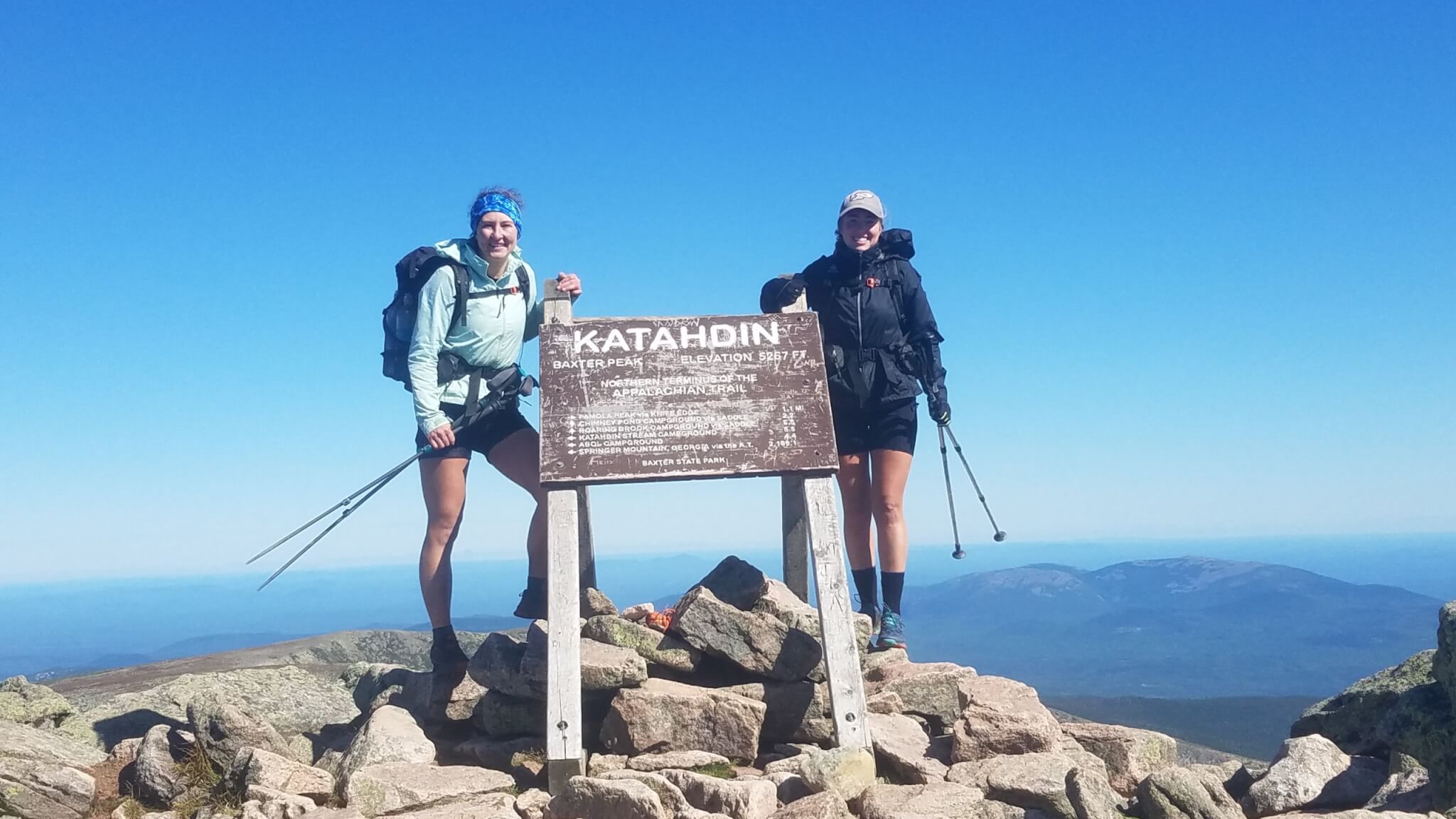
“It’s pretty crazy and incredible and hard for me to find words,” Rebekah says even still a few months later. “Four and a half months going towards this one goal and you’re like ‘it’s going to be done today and I’m doing it.’ I was still kind of sick at that point and a little nervous about the climb, but we made it up to the top. You can see the sign for the top of Katahdin that you see in all of the pictures. All of your friends in front of you have already been there. You know it’s coming and you see it off in the distance from quite a ways away.
“I got up there and just leaned against the sign. I thought I was going to cry. I actually didn’t, but I think I was just in too much shock. So much hard work goes into getting there. It is kind of bittersweet honestly, because you are like ‘oh, I’m done hiking,’ but it is also an incredible sense of accomplishment, especially when you know that so many people don’t make it. It was absolutely incredible to be up there. It was pretty special to be at the top, especially having Baleigh there as one of my best friends.”
Standout Moments: Trail Highlights
In addition to the people, the trail offers the perks of stunning vistas and wildlife encounters across 14 states as well as terrain to challenge even the most experienced hiker.
“It’s a really cool way to see 14 states on the Eastern side of the United States,” Lumkes said. “Getting to hike through them and getting to be at a different spot every day and seeing new things was really cool.”
Rebekah's Top Sites
- The White Mountains in New Hampshire. “In New Hampshire you have the hardest climbs and the hardest descents. You are rock climbing more than you are hiking and you have to pull yourself up on these ledges. But then you get up to the top and you are above tree line and there are 360-degree views of mountains, the best views of the entire trail.”
- The Smoky Mountain National Park in Tennessee and North Carolina. “When we were there it was still spring so none of the trees had leafed out, so you had really good views. It was gorgeous down there.”
- Grayson Highlands in Virginia. “It was cool because it is like a completely different ecosystem where it was open but you weren’t necessarily at a high elevation. It is very rocky and more shrubland.”
Baleigh's Top Sites
"All of the New England states are really pretty, but the whole trail was pretty, even starting in Georgia with the rhododendron forest. I had never experienced one of those before, so I was like, ‘wow, I feel like I am in a rainforest.’”
- Max Patch and Big Bald in North Carolina. “Max Patch was a really cool bald and Big Bald had one of the best sunsets that we saw on the trail.”
- McAfee Knob and Tinker Cliffs in Virginia. “McAfee Knob is known as THE place for sunrises. It is one of the iconic picture-taking spots on the trail and it does not disappoint.”
- Harper’s Ferry in West Virginia. “Harper’s Ferry is the “mental halfway point” so that’s right about 1000 miles. It is a really cool historic place.”
Takeaways: Lessons Learned
Since the hike concluded in September, both Rebekah and Baleigh have returned to the workforce, in nature of course, wiser and stronger from their journey.
After taking a little time to reintegrate herself into “normal life,” Rebekah is back in Georgia, about a half hour from where they started the hike, working as a crew leader on a whitetail deer research project for the winter, while applying to grad schools.
“I am doing a lot of hiking right now because I am back in the Appalachian Mountains,” she shared. “I’m out of hiking shape, but I’m like, well I’ve done this before so I can hike up this mountain. Or, if it is pouring rain and we’re out doing fieldwork, I am like 'I’ve been in worse, so this is fine.' There’s a lot of mental toughness that came from the trail that I use in everyday life now. I tell myself, ‘well, I was able to do that and stay focused that long, I can do this too.'"
As for hiking, Rebekah has big plans for the future, and hopes to take aim at the Pacific Crest Trail and Continental Divide to finish the triple crown. She also has looked at the Colorado Trail, the Long Trail in Vermont and an 1800-mile walking trail in New Zealand.
“I remember on Day 5 of 6 of the Appalachian Trail saying ‘I never want to leave; this is great.’ Then I finished and I was like, ‘I want to go do another one’. I am addicted now, it is just finding the time and money in my life to do these things.”
As for Baleigh, she is back in her hometown of Fort Wayne, Indiana, working as an educator for the Fort Wayne Children’s Zoo.
“I was sad to leave a job that I absolutely loved (at the Dunes Learning Center) but personally and professionally, I think the trail has grown me in a lot of aspects. I am very thankful and blessed that I had the opportunity to hike and now I am right back into my field.”
But would she return to the trail?
“I would have told you the day that I finished that I was one and done; I had no desire to ever hike again,” Baliegh said. “Now, and even two days after I was finished, I think ‘I would hike this again’. My fiancé and I have actually talked about going and doing it again or at least sections of it because I truly loved the trail community and, overall, I had a great experience on the trail. I would maybe try the Pacific Crest or the Camino Royale. Maybe I’d stick to initially some short backpacking trips versus several months. I don’t know, we’ll see.”
Both women are thriving individually, but what about as a pairing? What does 2200 miles of hiking, eating together, sleeping in the same tent, etc., do to a friendship?
If anything, both women say they are closer after their shared experience.
“We had our ups and downs, literally and figuratively,” Rebekah said. “We shared a lot of stuff: a tent, a cooking pot, a stove. When you’re in that with someone, you’re going to have some arguments, especially when you are both trying to plan where to go, but we are definitely better friends now. It is so special to me to have someone who was there with me every single day from beginning to end. We can remember those experiences together. Baleigh is a champ. She did awesome. I was so proud of her the entire time. It was awesome to get to share all of those things with someone you are already best friends with and then be able to have that for the rest of your life.”
Baleigh couldn’t agree more.
“She started the trail as my best friend and we ended the trail still as best friends,” she said. “People asked ‘are you sure you can hike the trail with one person every single day and share supplies?’ We said absolutely. We learned we weren’t the perfect hiking buddies, but that doesn’t change the fact that she is my best friend and someone I can share this with. It is really hard to explain the trail or have people truly understand what it’s like unless they have been out there. I tried to explain to my fiancé about how everyone is instantly your friend and that one of the beauties about hikers is that you want to see everyone succeed and he had a hard time understanding that. It is a really niche, special community that you don’t understand unless you have been out there. So the fact that I’m able to share that with my best friend is really cool.”
For More Trail Tips From Baleigh and Rebekah Click Here
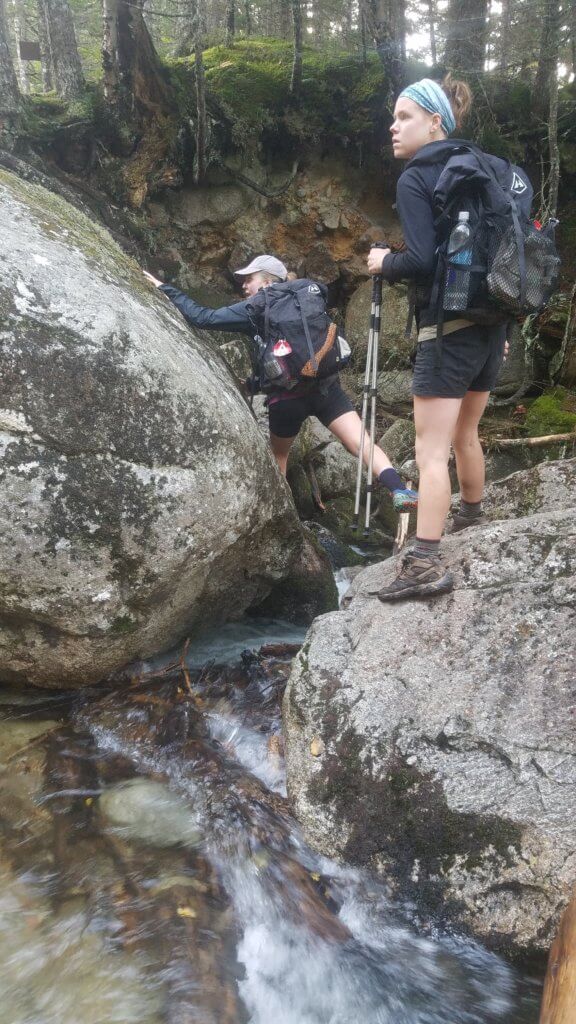 Baleigh and a tramily (trail family) member hike on rocks over water.
Baleigh and a tramily (trail family) member hike on rocks over water.  Baleigh in a tent near Kent, CT.
Baleigh in a tent near Kent, CT. 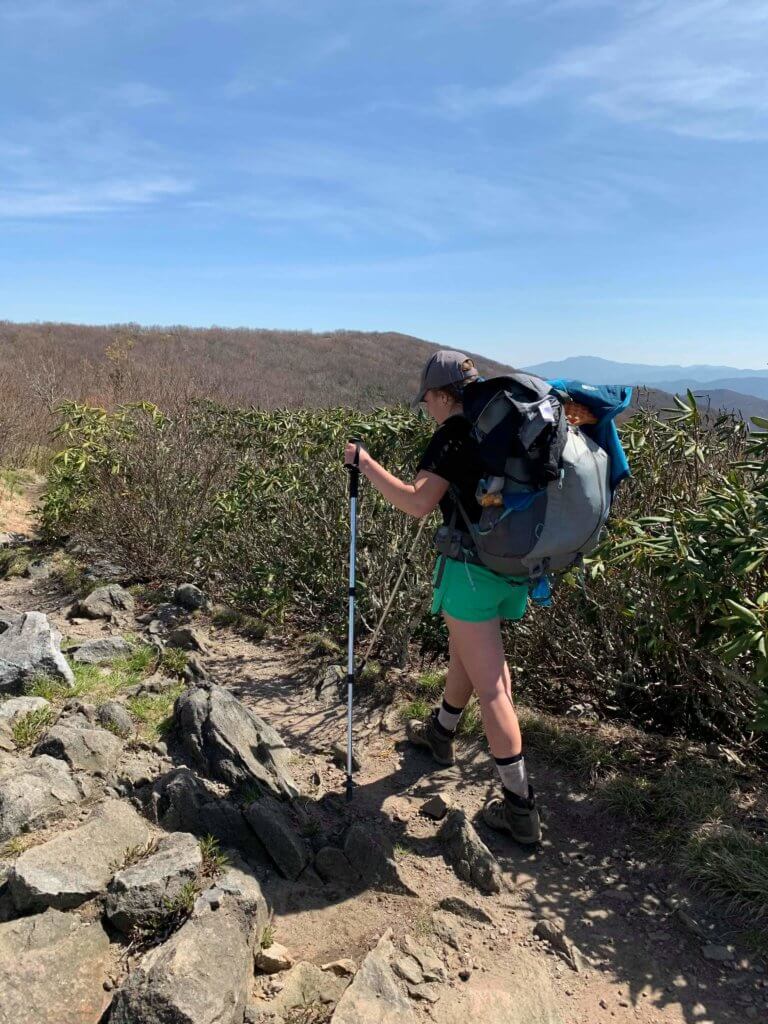 Hiking at the Smoky Mountain National Park.
Hiking at the Smoky Mountain National Park. 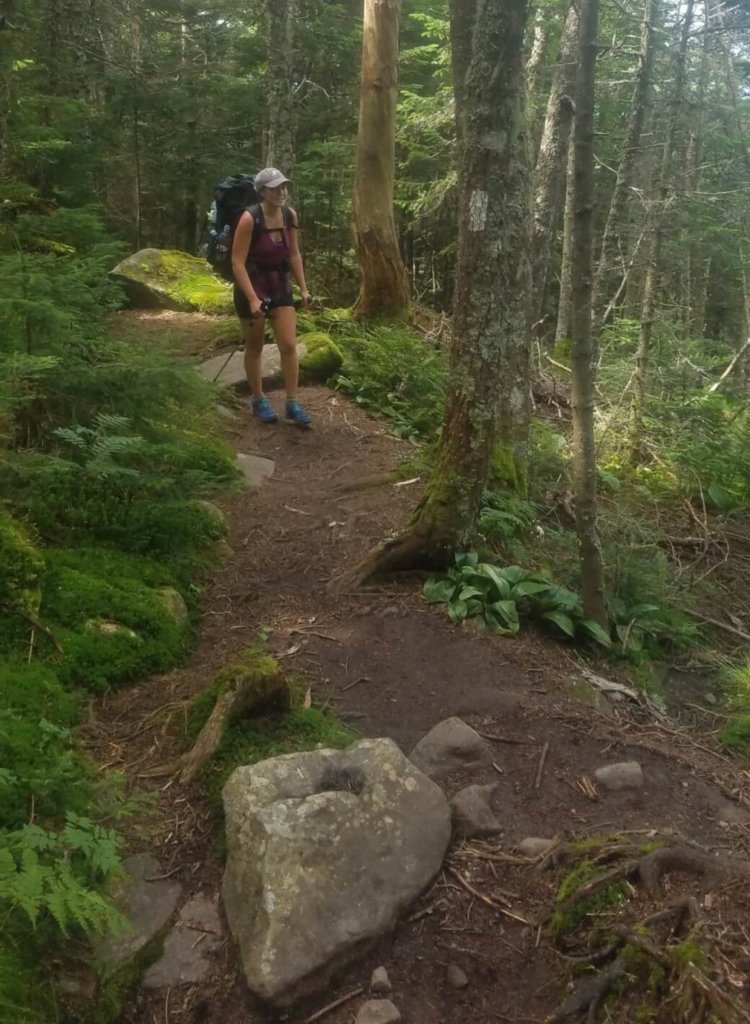 Baleigh hiking up Mount Moosilauke.
Baleigh hiking up Mount Moosilauke. 
